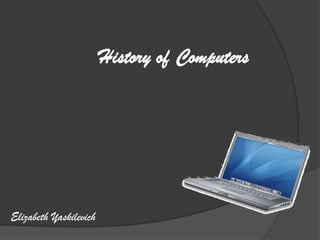
History of computers
- 1. History of Computers Elizabeth Yaskilevich
- 2. The very first calculating device used was the ten fingers of a man’s hands. This, in fact, is why today we count in tens and multiply of tens.
- 3. Then the abacus was invented, a bead frame in which the beads are moved from left to right. People went on using some form of abacus well into the 16th century, it is being used in some parts of the world because it can be understood without knowing how to read.
- 4. During the 17th and 18th centuries many people tried to find easy ways of calculating. J.Napier, a Scotsman, devised a mechanical way of multiplying and dividing, which is how the modern slide rule works. Henry Briggs used Napier’s ideas to produce logarithm which all mathematicians used today.
- 5. The first real calculating machine appeared in 1820 as the result of several people’s experiments. This type of machine, which saves a great deal of time and reduces the possibility of making mistakes, depends on a ten-toothed gear wheels.
- 6. In 1830 Charles Babbage, an Englishman, designed a machine that was called ‘The Analytical Engine’. This machine, which Babbage showed at the Paris Exhibition in 1855, was an attempt to cut out the human being altogether,expert for providing the machine with the necessary facts the problem to be sowed. He never finished this work, but many of his ideas were the basis for building today’s computers.
- 7. In 1930, the first analog computer was built by Vannevar Bush. The device was used in World War II to help aim guns. Mark I, the name given to the first digital computer, was completed in 1944. This was the first machine that could figure out long of mathematical problems all at a very fast speed.
- 8. In 1946 two engineers at the University of Pennsylvania, J.Eckert and J.Mayshly, built the first digital computer using parts called vacuum tubes. They named their new invention UNIAC. The first-generation of computers, which used vacuum tubes, came out in 1950. UNIAC I was an example of these computers which could perform thousand of calculations per second.
- 10. In 1960, the second generation of computers was developed and could perform work ten times faster than their predecessors. The reason for this extra speed was the use of transistors instead of vacuum tubes. Second-generation computers were smaller, faster and more dependable than first generation computers.
- 12. The third-generation computers appeared on the market in 1965. These computers could do a million calculations a second, which is 1000 times faster than the first generation computers. Unlike second-generation computers, these are controlled by tiny integrated circuits and are consequently smaller and more dependable.
- 13. Fourth-generation computers have now arrived, and the integrated circuits that are being developed have been greatly reduced in size. This is due to microminiturization, which means that the circuits are much smaller than before; as many as 1000 tiny circuits now fit onto a single chip. A chip is a square or rectangular piece of silicon, usually from 1/10 to 1/4 inch, upon which several layers of an integrated circuit are attached or imprinted, after which the circuit is encapsulated in plastic metal. Fourth-generation computers are 50 times faster than third-generation computers and can complete approximately 1.000.000 instructions per second.
- 15. Thank you for attention!